
|
 |

|
 |
Tanya Saxena on her dance film 'Bindu' - Shveta Arora e-mail: arorashveta1806@gmail.com April 9, 2023 Bharatanatyam dancer Tanya Saxena showcased her dance film 'Bindu' digitally in the Indo-American Arts Council's Erasing Borders Dance Festival in 2022. Bindu was inspired by a painting by legendary artist S.H. Raza. Tanya speaks about the process of conceptualizing the film, choreographing the piece and filming an Indian classical dance piece. 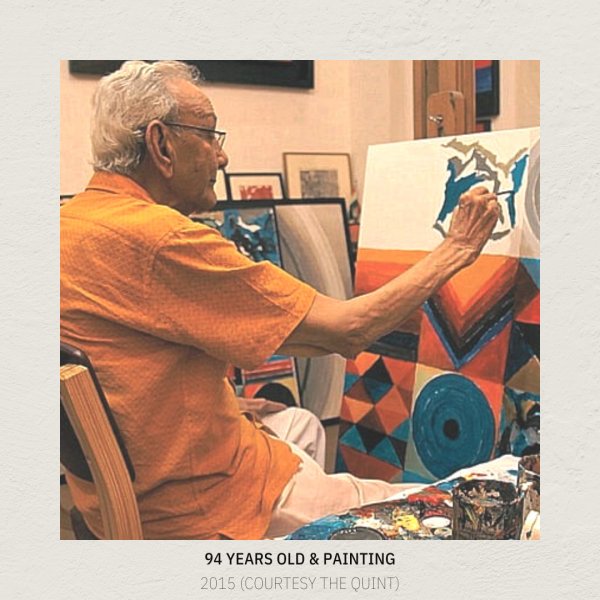 Artist Raza painting I wanted to know your perspective of the painting - how did you perceive it? What was your thought process and how did you conceptualize the film? It's not something that was entirely straightforward because I was working with imagery - what the painting evoked and was touching upon. In the research that I read, and in seeing Raza's paintings over his career span, he really focused on boiling down something to its essence, or the essence of how he perceived it. It's very clear in the painting itself because he's included the word 'Prakriti' in the painting. Making that choice leads your mind to a certain way, into looking at these shapes and colours, making those connections with nature. I can't dissociate looking at the painting with everything I've read about him, his journey and his work. So for me, the painting and the man were equally inspiring (especially the latter) as someone who would consistently push boundaries. 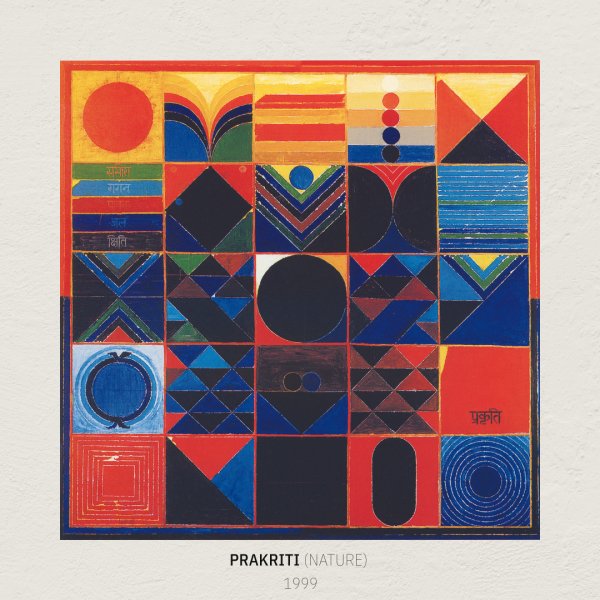 Prakriti (Nature) The painting itself is alluding to nature and the building blocks of nature, and he has distilled that down to simple shapes, very vivid usage of colour and a neat interlocking grid pattern of different shapes. One can argue that nature is not always so neat and organized, but in his version of things, it is. And so, I think, when I was looking at the painting, I was just trying to make these connections with these colours and these shapes in nature which we see around us and within us. Another thing that's really potent for him is the bindu. For him, that bindu was like the source of life and he uses the colour black to represent it. The colour black, he says, has all the colours within it, and I was drawing that connection to the singularity of the Big Bang and how that was the source of all life as we know it. He uses these different colours to represent the different elements of nature in classical Indian philosophy. It's these colours and these shapes that come together in different ways. So when I think about wind, it's about the air we breathe and our very breath, as well as the external idea of wind and air that's moving. Similarly with water, it's blood that's gushing in our veins as well as the rain and the lakes, the oceans and all of that. I've tried to draw these connections with the very distinct patterns that he's made. Similarly, there's earth. In the film, there is this whole portion where there's an intertwining with a tree that's going up, and that tree is supposed to represent, in some ways, the growing of the skeleton and the muscles from the earth etc. And then there's the sun. The sun is the source of energy. If you look at our own bodies, that would be our stomach, which converts all the food we eat into the energy that we expend. Then it ends with the idea of space, which is the fifth element in Indian philosophy. When we think of nothingness, we think of lifelessness. But it's interesting to think of spaces in our body which, if they weren't empty spaces, then life really wouldn't be there. And then, in the painting itself, he has also used the imagery of these intertwining snakes which was very, very familiar. It really struck a chord with Indian philosophy and the kundalini, which is basically what the snakes represent. He's also represented the male and female principle - two triangles, one is inverted and one is straight. The intertwining of the two, which he showed with the snakes, I've shown in a different way with the film. At the end of the day, it's actually about that process of thinking and questioning and wondering what it is that the artist is trying to represent. That is actually what makes the painting itself worthwhile. That is what I actually found quite enriching about the process of creating the film or the ideation of it. 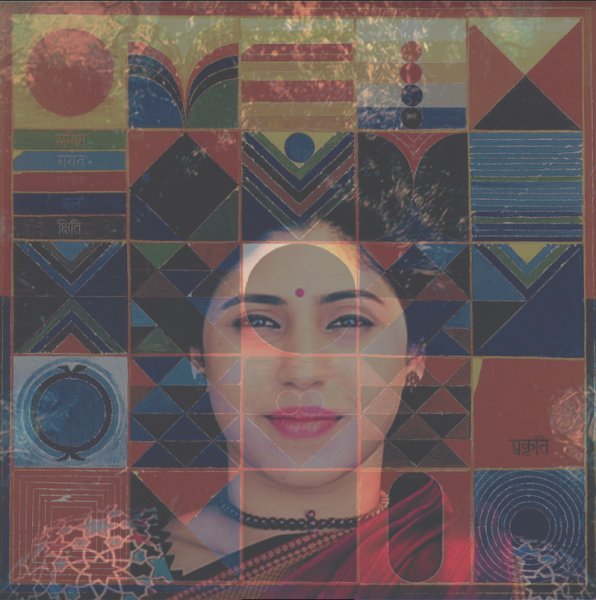 What do you think about this new form of performance that has come up? You're basically shooting, you're not performing. You are not in your proper aharyam and you were casually dressed for this film. In fact, I think I could make out the strap of your watch at one point. Yes, at one point. That was a mistake, actually, including the watch. But I liked the shot and it was the only one, we didn't have any without the watch at that point. I liked that shot also because it shows these different elements coming out of the body. And the body itself is also in this tree-like nature pose, so we included it anyway. In terms of the new language that's being developed, it is very much being developed for me. I'm only talking about my experience. This was one of the first films I did. In fact, it was before the video I put out, 'Charkha'. It just so happened that we had a commission with the Raza Foundation and there was enough funding to support a project like this, and so we had the wherewithal to shoot it and start editing it, start the process of making it, which got completed later when Erasing Borders selected it for screen dance and provided further funding. But yes, it's a lot of learning that one goes through, because the camera can do a lot of things. And I was really exploring, what can the camera do in this process? I was directing it myself so I was behind the camera as well. I had to storyboard and look at the painting, at how I was thinking of recreating that image and at the choices I had, because I had my body as well as the camera. There are certain times where I have chosen to represent an image solely with the language of film, versus sometimes when I'm representing it solely with the language of dance, or dance in combination with visuals. I cannot speak about the larger trend because I think this is a trend that has existed for quite a while. It's just that the classical dance audience doesn't get to see them as much. Our exposure to it is low, which I think is becoming greater now that a lot of work has shifted online or on the screen due to COVID-19. That space has existed; I just don't think that we have been familiar with it. For me, it's the same thing - it's only when I started working on this film that I was put in a position where I had to make choices about how I tell the story, about all the things that are in front of me. What you're saying should come across in the best possible way or in the best way that you can put it forward. It's not that important for me for someone to come to a programme of mine or watch something like this, a film, and say, oh, this was Bharatanatyam. It's not about the form; it's about what the form is saying, what that piece of work is saying. It should leave you ideally with some kind of idea or thought or image or question. It was really about how I make this artist's work and voice shine through in the film. If someone is watching this, I want them to go back and try to read about how extraordinary this person and his art were and how it changed the art scene in India. 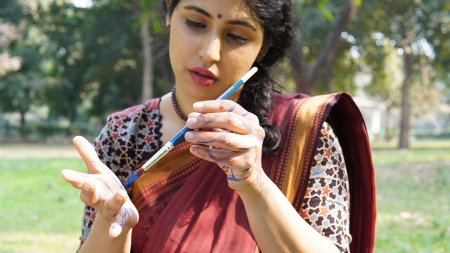 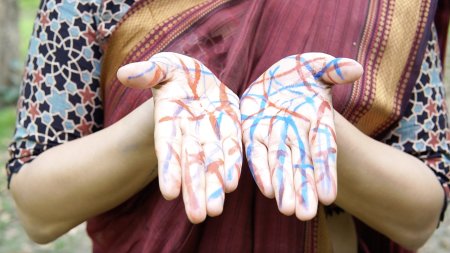 Tanya Saxena A live performance and a film are two totally different directions. When you choreograph something, do you have to keep that in mind right at the start? Yes. For a film, each shot is decided. I had a storyboard of each visual, how long I wanted it to be and the technical details of how we'd film it: what would the camera angle be, how we would move the camera while it's happening. And the choreography was something that was part of that ideation. Each of those elements was designed. Then of course, when you go to the space, resources are limited, so you improvise a little bit. Then you have this beautiful shot, but you see if its inclusion benefits the storyline. There were some beautiful shots that we got which we didn't end up including at all. It was destroying the pace of the film, which is already quite slow. I felt like there was a lot of neatness in the canvas, and I was trying to mimic that in the treatment of the film. The choice of going from one element to another was also how intertwined all these things are in nature. These transitions are so smooth, you can't even really differentiate where one starts and one ends. It's very technical. That is the approach that we used this time. But that is also an approach I think I adopted because I used this project to learn about filmmaking in many ways. Normally, when we shoot in dance, we get the music and we'll choreograph to that. But in this case, I made the film and then sent it to the sound artist, Anando, and to Rajat. I gave them some ideas, they did some stuff and sent things back. It's important that the music came after the film was ready, which is, again, opposite to the way we work in dance. It's a very different process. At the end of the day, however, they're all part of the overarching field of art. It's just a different medium. 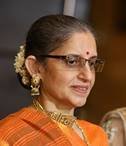 Shveta Arora is a dance-mad writer who chronicles classical dance events in Delhi (and also those online). In 2009, she started the blog Kala Upasana at delhiculturecomment.blogspot.com, where she began posting her own writing along with photographs clicked by Anoop Arora, her husband. She's been dancing all her life as a devotee, but resumed her formal training in Kathak in her 50s and has passed her fifth year Kathak exams. Post your comments Please provide your name and email id when you use the Anonymous / blog profiles to post a comment. All appropriate comments posted with name and email id in the blog will be featured in the site. |